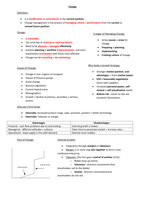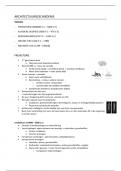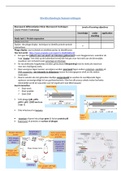Definition:
Is a modification or amendment in the current position.
Change management is the process of managing culture + performance from the current to
revised future position.
Change:
4 stages of Managing Change:
Is inevitable.
Id key causes + areas for
Can arise due to internal or external factors. change.
Need to be planned + managed effectively. Preparing + planning.
Involves planning + sensitive implementation, and most Implementing.
importantly consultation with those most affected.
Creating culture of change.
Change can be unsettling + de motivating.
Why Seeks a Growth Strategy:
Causes of Change:
Stronger market position, cost
Change in size: organic or inorganic. advantages + more market power.
Impact of Pressure groups EOS + favourable negotiation
Social change. terms with suppliers.
Business legislation. Increased personal power, self-
Current topical areas. esteem + self actualisation needs.
Demographics. Reduce risk - easier to ride out
Growth + decline of primary, secondary + tertiary economic fluctuations.
sectors.
How can a Firm Grow:
Internally: Increased product range, sales, premises, workers + better technology.
Externally: Takeover or merger.
Advantages Disadvantages
Financial - cash flow problems due to overtrading. Internal growth is slower.
Managerial - different attitudes + cultures. Takes time to penetrate market + increase sales.
Operational - keep supply in line with demand. External more sudden.
Pace of Change: External Growth:
Integration through mergers or takeovers.
Merger: 2 or more orgs join together to form a new
combined enterprise.
Takeover: One firm gains control of another (51%)..
o Bidder buys up shares.
o Voluntary - directors recommend that
shareholders sell to the bidder.
o Hostile - directors recommend that
shareholders do not sell.










